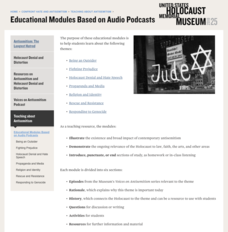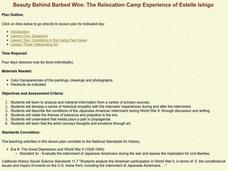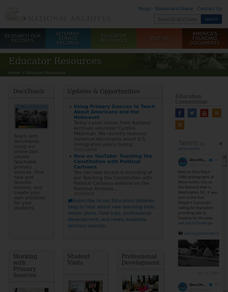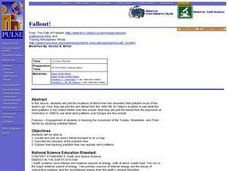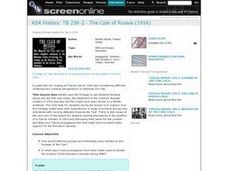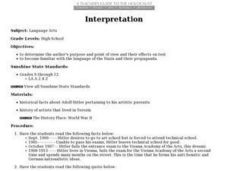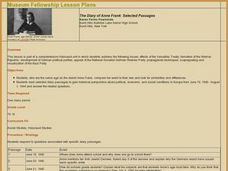US Holocaust Museum
Educational Modules Based on Audio Podcasts
Imagine hearing someone claim an event like the Holocaust never happened. Pupils use audio podcasts and reading passages to dive into the lives of those impacted by the Holocaust of World War II. Using the information they gather, class...
Curated OER
Brave New World
Students view a video about the effects of World War II on the map of Europe. They discuss the video and answer questions. They work together to identify accomplishments that best represent American culture.
EngageNY
Building Background Knowledge: The Internment of Japanese-Americans during WWII, Part 4
Learners use a Analyzing Mediums handout to detail the advantages and disadvantages of communicating with mediums such as artwork, photographs, and political cartoons in the Japanese-American Internment during World War II primary...
Curated OER
Art and Patriotic Culture
Art forms, especially government-sponsored "poster art", very effectively conveyed specific cultural values during World War II. Understanding the role that visual images play in expressing issues and ideas is critical to developing...
Curated OER
Beauty Behind Barbed Wire: The Relocation Camp Experience of Estelle Ishigo
Eighth graders study World War II through art.
Curated OER
Memorandum Regarding the
Students use the National Archives to research the memorandum regarding the enlistment of Navajo Indians during World War II.
Curated OER
Fallout
High schoolers view a short film about the results of dropping the atomic bomb at the end of World War II. They research controversies surrounding the use of the bomb and nuclear weapons. They write two editorials about the issue.
Smithsonian Institution
POWs
Why did Vietnam POWs and their families receive more media attention than POWs in previous wars? To answer this question, class members view artifacts, read articles, and engage in class discussion. Individuals then assume the...
Curated OER
The Diary of Anne Frank: Research Project on Concentration Camps during World War II
Eighth graders investigate the Holocaust and the persecution of specific ethnic groups in Europe during World War II.
Curated OER
WWI and Russian Revolution
Students view and discuss footage of Tsar Nicholas II reviewing troops on the Eastern Front in 1916 and examine how different groups would have reacted to this footage of the Tsar. They watch the video and in small groups answer...
Curated OER
Selling Warfare - Propaganda Posters
Students examine the use and purpose of propaganda posters during World War I. They work in groups to create a propaganda poster supporting a nation's war effort.
Curated OER
Interpretation
Students research and discuss historical facts about Adolf Hitler's artistic pursuits, and the history of artists that lived in Terezin.
Curated OER
Adolf Hitler: Was Hitler a Passionate Lunatic?
Young scholars investigate WWII by researching Adolf Hitler. In this dictator biographical instructional activity, students identify the role Adolf Hitler played in the self destruction of Germany by reading secret transcripts from...
Curated OER
Propaganda of War
High schoolers examine examples of war propaganda. In this historical literature lesson, students research the elements of propaganda in relation to various wars of the past. They discuss different types of propaganda, and...
Curated OER
World War Ii - Japanese American Internment
Ninth graders determine that nationality is not defined by race, especially in the United States. They group into teacher created dyads with eight pictures. Four pictures are of American citizens (multiracial representations), and...
Foreign Policy Research Institute
Propaganda - 9/11 and the War on Terrorism
Propaganda is an important topic that most high school social studies teachers address. Here, students compare and contrast methods of public persuasion during WWII with those used in the contemporary War on Terror. Research, discussion,...
Curated OER
Teaching With Documents: Powers of Persuasion - Poster Art of World War II
Young scholars analyze 11 posters from wartime and complete a worksheet. They discuss the similarities and differences between the posters and where the posters might have been posted. Student volunteers from each group present the...
Curated OER
The Homefront: America and WWII
Students are introduced to the experiences of various groups of Americans at home during WWII, highlighting race, gender, and ethnicity. They improve their ability to analyze and interpret historical documents and images.
Curated OER
Patriotic Arts: Influencing Canadians At War
Students study how war has shaped Canadian life, patriotism, propaganda, and music. They research primary source documents, novels, videos, and songs before celebrating Remembrance Day.
Curated OER
The Home Front - "Use It Up, Wear It Out, Make It Do Or Do Without!"
Students examine documents that explore U.S. government advertisements from the WWII era that encouraged people to grow victory gardens, recycle and conserve resources as part of the war effort. They discuss propaganda and design their...
Curated OER
Writing About Pearl Harbor
High schoolers summarize the reasons why the U.S. entered World War 2. They view a video on the bombing of Pearl harbor, construct a timeline of WWII events, and evaluate propaganda posters to create their analysis of the start of U.S....
Curated OER
One Survivor Remembers: Anti-Semitism
Students analyze and discuss how propaganda influenced anti-Semitism and it's role in World War II. For this propaganda lesson, students define the terms involved in this assignment. Then they will discuss their reactions to a film and...
Curated OER
The Diary of Anne Frank: Selected Passages
Students read the novel, "The Diary of Anne Frank". Using the internet, they gather information on the effect of the Versailles Treaty, formation of the Weimer Republic and the Nazi Party on the Holocaust. They view propaganda...
Curated OER
Anne Frank: Critical Thinking
Students read a story by James Clavell about propaganda and they discuss how it was used in the story. In groups, they decide what they would do if faced with certain situations.


